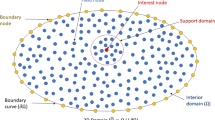Abstract
The Fokker–Planck equation on conservation form modeling stochastic chemical reactions is discretized by a finite volume method for low dimensional problems and advanced in time by a linear multistep method. The grid cells are refined and coarsened in blocks of the grid depending on an estimate of the spatial discretization error and the time step is chosen to satisfy a tolerance on the temporal discretization error. The solution is conserved across the block boundaries so that the total probability is constant. A similar effect is achieved by rescaling the solution. The steady state solution is determined as the eigenvector corresponding to the zero eigenvalue. The method is applied to the solution of a problem with two molecular species and the simulation of a circadian clock in a biological cell. Comparison is made with a Monte Carlo method.
Similar content being viewed by others
References
N. Barkai and S. Leibler, Circadian clocks limited by noise, Nature, 403 (2000), pp. 267–268.
H.-J. Bungartz and M. Griebel, Sparse grids, Acta Numer., 13 (2004), pp. 147–269.
J. C. Dunlap, Molecular bases for circadian clocks, Cell, 96 (1999), pp. 271–290.
M. Ehrenberg, J. Elf, E. Aurell, R. Sandberg, and J. Tegnér, Systems biology is taking off, Genome Res., 13 (2003), pp. 2377–2380.
J. Elf, P. Lötstedt, and P. Sjöberg, Problems of high dimension in molecular biology, in High-dimensional Problems – Numerical Treatment and Applications, W. Hackbusch, ed., Proceedings of the 19th GAMM-Seminar Leipzig 2003, pp. 21–30, available at http://www.mis.mpg.de/conferences/gamm/2003/.
J. Elf, J. Paulsson, O. G. Berg, and M. Ehrenberg, Near-critical phenomena in intracellular metabolite pools, Biophys. J., 84 (2003), pp. 154–170.
L. Ferm and P. Lötstedt, Adaptive error control for steady state solutions of inviscid flow, SIAM J. Sci. Comput., 23 (2002), pp. 1777–1798.
L. Ferm and P. Lötstedt, Accurate and stable grid interfaces for finite volume methods, Appl. Numer. Math., 49 (2004), pp. 207–224.
C. W. Gardiner, Handbook of Stochastic Methods, 2nd edn., Springer, Berlin, 2002.
D. T. Gillespie, A general method for numerically simulating the stochastic time evolution of coupled chemical reactions, J. Comput. Phys., 22 (1976), pp. 403–434.
A. Golbeter, Computational approaches to cellular rhythms, Nature, 420 (2002), pp. 238–245.
E. Hairer, S. P. Nørsett, and G. Wanner, Solving Ordinary Differential Equations, 2nd edn., Springer, Berlin, 1993.
N. G. van Kampen, Stochastic Processes in Physics and Chemistry, North-Holland, Amsterdam, 1992.
R. B. Lehoucq, D. C. Sorensen, and C. Yang, ARPACK Users’ Guide: Solution of Large-Scale Eigenvalue Problems with Implicitly Restarted Arnoldi Methods, SIAM, Philadelphia, 1998.
P. Lötstedt, S. Söderberg, A. Ramage, and L. Hemmingsson-Frändén, Implicit solution of hyperbolic equations with space-time adaptivity, BIT, 42 (2002), pp. 134–158.
K. W. Morton, Numerical Solution of Convection-Diffusion Problems, Chapman & Hall, London, 1996.
Y. Saad and M. H. Schultz, GMRES: A generalized minimal residual algorithm for solving nonsymmetric linear systems, SIAM J. Sci. Stat. Comput., 7 (1986), pp. 856–869.
M. Thattai and A. van Oudenaarden, Intrinsic noise in gene regulatory networks, Proc. Natl. Acad. Sci., 98 (2001), pp. 8614–8619.
J. M. G. Vilar, H. Y. Kueh, N. Barkai, and S. Leibler, Mechanisms of noise-resistance in genetic oscillators, Proc. Natl. Acad. Sci., 99 (2002), pp. 5988–5992.
Author information
Authors and Affiliations
Corresponding author
Additional information
Dedicated to Björn Engquist on the occasion of his 60th birthday.
AMS subject classification (2000)
65M20, 65M50
Rights and permissions
About this article
Cite this article
Ferm, L., Lötstedt, P. & Sjöberg, P. Conservative solution of the Fokker–Planck equation for stochastic chemical reactions . Bit Numer Math 46 (Suppl 1), 61–83 (2006). https://doi.org/10.1007/s10543-006-0082-z
Received:
Accepted:
Published:
Issue Date:
DOI: https://doi.org/10.1007/s10543-006-0082-z




